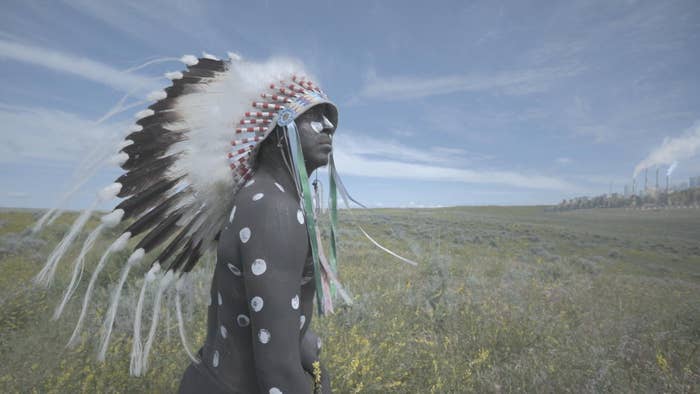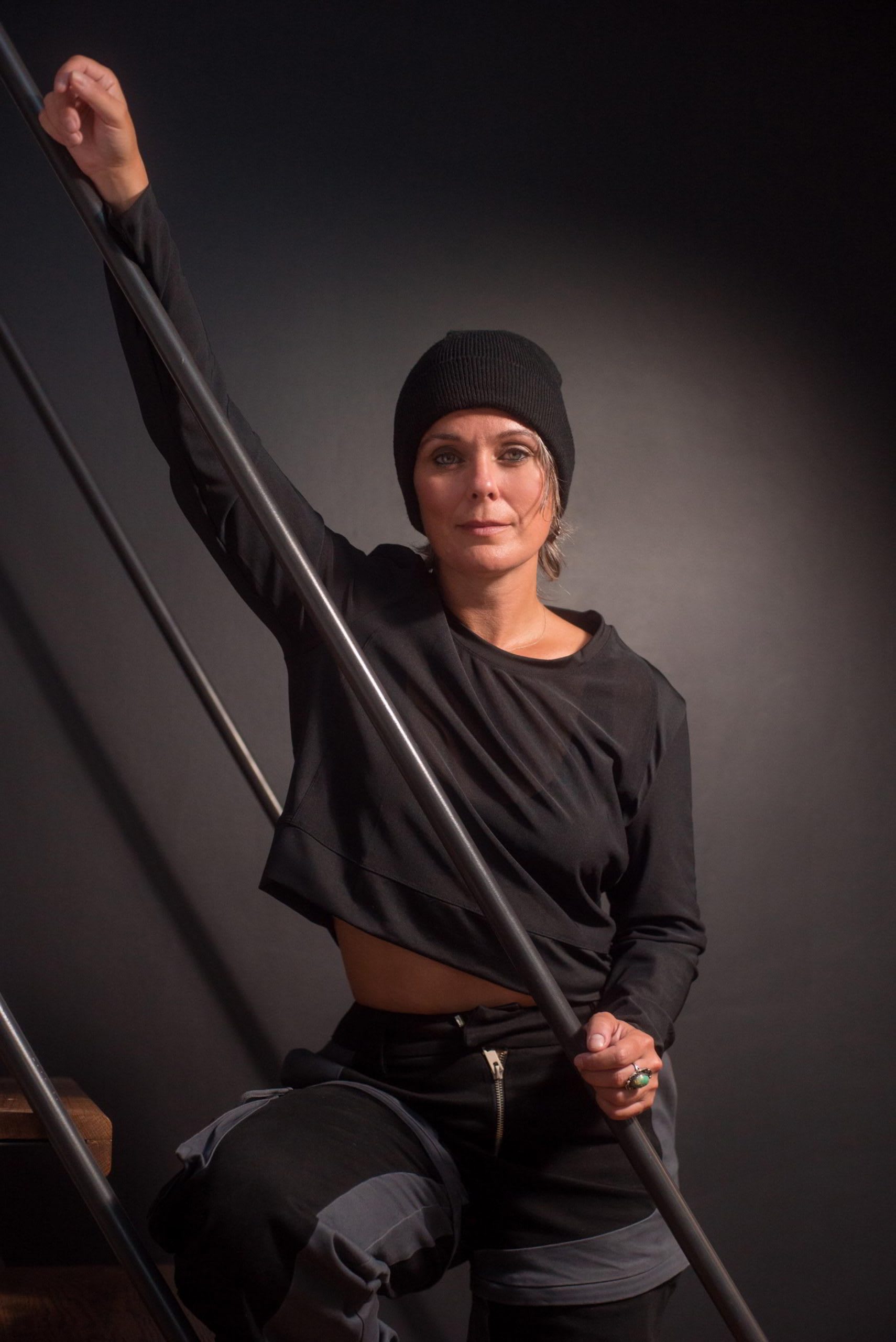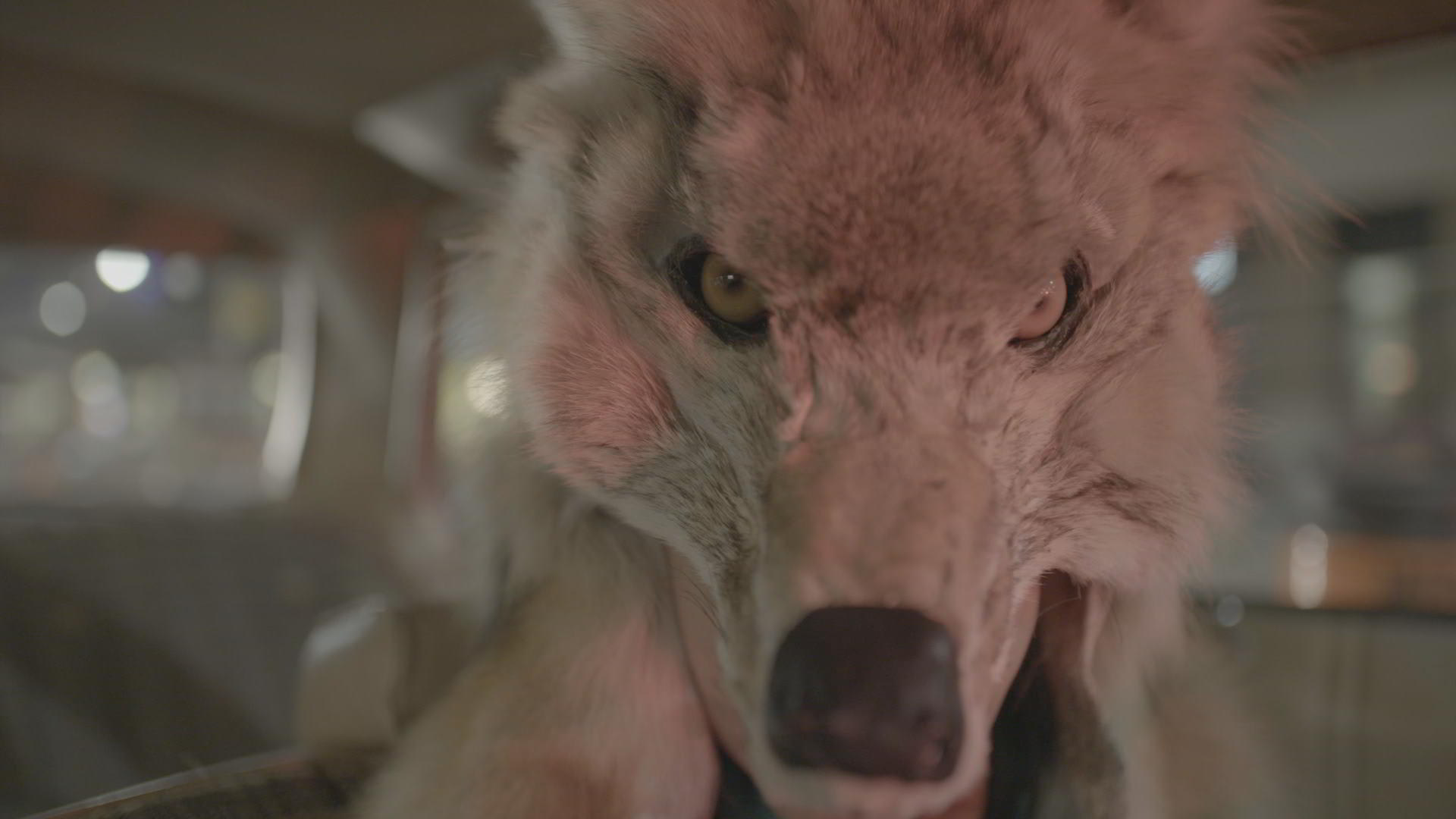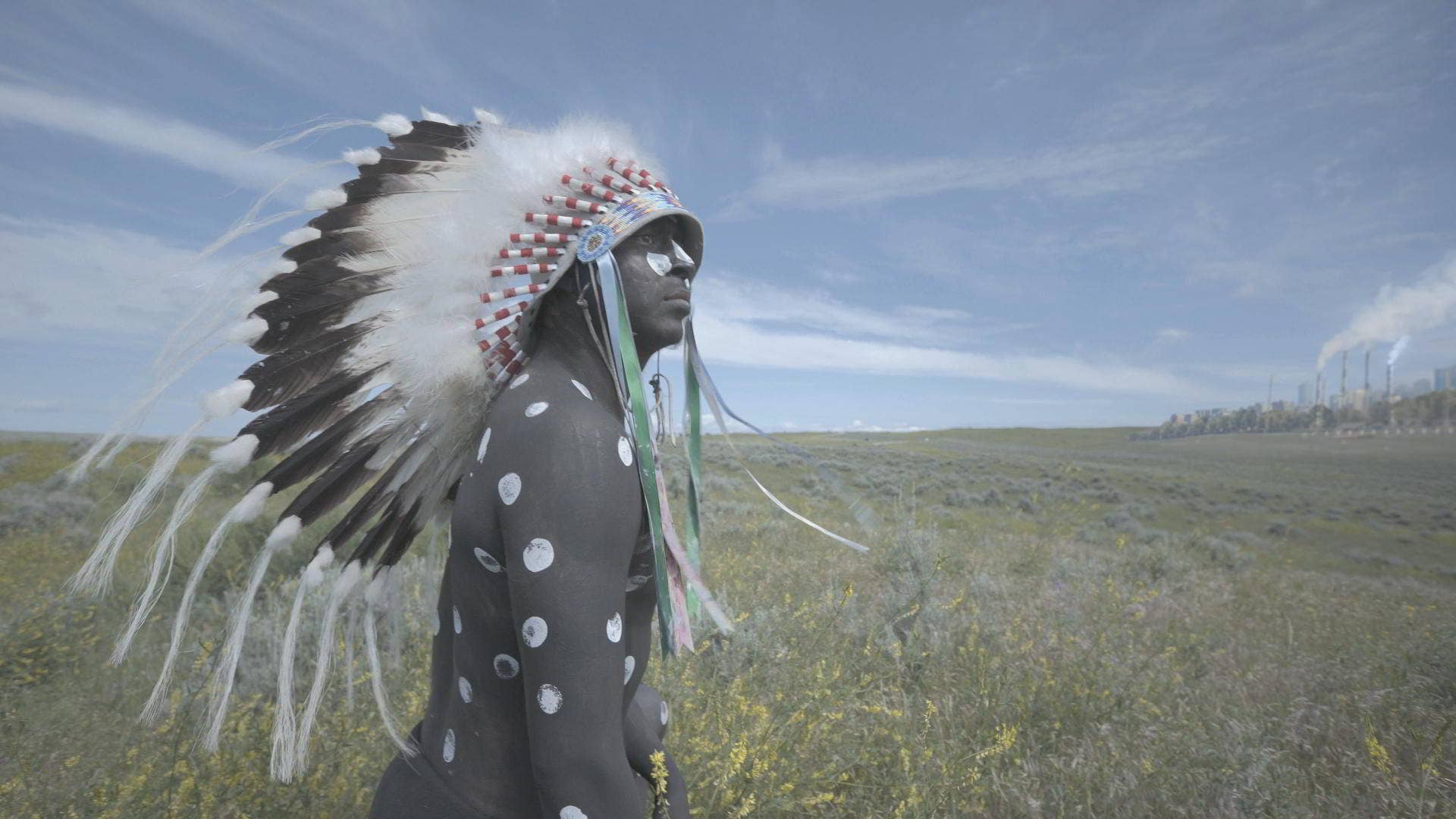
Call Michelle Latimer the talent to watch at TIFF 2020. The Algonquin/Métis filmmaker has two projects among TIFF’s scaled-down 50 film line-up: the feature documentary Inconvenient Indian, inspired by the book by Thomas King, and the CBC series Trickster, which adapts the book Son of a Trickster by Eden Robinson. (Latimer directs all six episodes of Trickster, two of which screen at TIFF, and is currently adapting a second season.) Both projects are arguably the most high profile and eagerly anticipated Canadian work at the festival. But they’re also natural progressions in Latimer’s career as she’s stood out among her generation of filmmakers.
Latimer’s works, diverse as they are, define themselves with a clear activist voice and a desire to push formal terrain while exploring urgent issues, most often affecting Indigenous communities. The animated short Choke (2011) announced Latimer as a talent to watch with its portrait of drug addiction and the lateral violence of residential schools, with haunting stop-motion animation fueled by the vocals of David Lynch on the soundtrack. Her debut feature doc Alias (2013) profiled diverse voices in Toronto’s hip-hop scene, which has obvious influence on Trickster, where urban beats propel the story of teen protagonist Jared (Joel Ouellette) as he comes of age in Kitimat, BC, amid a battle between his (literal) witch of a mother (Crystal Lightning) and his mysterious father (Kalani Queypo), who returns from the dead to pass on the legacy of the trickster to his son.
Tricksters, those shape-shifters also known by names like Nanabush, Glooscap, and Wisakedjak, are figures from Indigenous culture that connect people of the Earth with the supernatural world. Tricksters figure prominently in Inconvenient Indian, as King rides around Toronto in a taxi driven by a Coyote (Gail Maurice) and his narrative recounts how Indigenous communities in Canada shift shape to survive. Latimer’s own ability to shift shapes partly defines her career, emerging as a notable talent behind the camera after acting in films like Resident Evil and series like Paradise Falls and Blackstone. Although her body of work includes both fiction and non-fiction, her documentary has brought her the most attention as a director, most notably with the Viceland mini-series Rise, which tackled issues of Indigenous sovereignty in the wake of the 2016 protests at Standing Rock.
Complex spoke with Latimer ahead of the 2020 Toronto International Film Festival to learn more about her new projects and her road so far.
Trickster seems to be a much larger project in terms of scope and scale compared to what you’ve done before. What was it like making that leap?
I had directed television series before, but I’ve never created my own series in my own vision. I was probably the most naïve about the pure magnitude of how much I would be immersed and for how long. The pure magnitude of beginning-middle-end that starts with the germ of an idea in your head. The creative process is an articulation of that right through to posting [post-production]. When we wrapped production, which was 49 days, I went straight into post-production. It’s a year of total immersion.
How did COVID affect the productions?
We were done the major editing for Trickster by the time COVID broke out. What was unique was our sound mixing and colour correction—that was all socially distanced. We did as much as we could online, so we would all log in to computers and use software so we could hear the same thing and look at the same picture. We waited until the later stages of re-opening when we could have four people in a room at six feet apart to finish mixes. Even then, it was challenging since it’s normally a much bigger process and more celebratory. For Inconvenient Indian, a huge part of that was edited remotely. I've worked with my film editor Katie Chipperfield for years. She edited some of the films for Rise, episodes for Trickster, and [the short film]Nuuca. For Inconvenient Indian, we would screen share for the edit using Zoom. I realized how much time I spent looking at the back of her head while editing other projects. As soon as we were screen sharing, I could see her face. It made it more intimate and we were able to connect on different levels.

How did you develop the dynamic rhythm in Inconvenient Indian by paralleling archival footage with contemporary footage?
I did an all-archive based film called Nimmikaage[She Dances for People] out of the NFB archives. I spent weeks perusing hundreds of hours of archives, so I was familiar with the collection. I knew what prompted my curiosity the first time I'd searched through the NFB archives. I noticed an ethnographic gaze. It was rare to see Indigenous women or men looking at the camera, down the barrel of the lens. After going through hundreds of hours of archives, I can name on one hand the instances where the person looks into the camera lens and acknowledges being seen.
I was interested in provoking that idea because so much of Inconvenient Indian revolves around representation. The beauty of making film is that rhythm between the visuals and sound. I brought my sound designer Brennan Mercer, who was also the composer, on much earlier. Normally, the sound designer comes in after the edit is complete. We brought him on around the rough cut stage of editing. He was designing and we were editing simultaneously, so we would show things back and forth. Normally the sound designer fits into an editor's edit, but in this instance, it was more collaborative.
Watching both projects back to back, you really notice the nuance of the sound designs.
Sound is really important to me. I was actually 90 percent deaf and in a deaf classroom from Grade 1 to Grade 3. Growing up without sound in my early life, or a minimal understanding of sound, gave me a deeper appreciation for it as I got older.
"Indigenous artists have to be in the center of what messaging they're creating. We can't be expected to play into old stereotypes of what looks or feels Indigenous."
How did the adaptation processes differ in terms of bringing the books to screen?
With Inconvenient Indian, I worked thematically. It was intimidating because of the density of King’s book and the scope of the ideas. You couldn't possibly fit everything into a film, so I took the book and broke it down into themes. Then I brainstormed how to visualize those themes, like land sovereignty or treaty rights.
Whereas with Eden's book, there was a similar editorial process in that her books are sprawling. There are many characters and so many worlds, so it was a matter of editing down what could fit into six episodes with linear through lines that we could serialize and move the story forward, yet maintain the authenticity and spirit of her work. I would sometimes take two characters and put them into one based on what the character(s) represent in the story. Sophia [Jared’s grandmother] is a mixture of characters. Georgina too is a mixture of characters.
I liked seeing Gail Maurice appear as similar trickster-like characters playing Georgina in Trickster and then as Coyote in Inconvenient Indian. Why is she so appealing for that kind of role?
She was cast in Trickster first but shot her Coyote scenes for Inconvenient Indian first. She has a playfulness. Inconvenient Indian has three tricksters: there's Miss Chief Eagle Testicle, who is [artist] Kent Monkman's alter ego; the Coyote character played by Gail; and Thomas. He has a trickster's spirit. What I loved about Miss Chief and Coyote was the gender bending—how they played with gender norms and the colonization of sexuality in Western culture. It was only with the onset of Christianity that we started to have judgment based on sexuality. It was important to honour the legacy of two-spiritedness. You have access to other worlds and other magic when you're playing within those realms.
King’s opening monologue in Inconvenient Indian speaks to the power of stories and how we have to watch out for that power. Do you recall when you realized that the films you watched didn't reflect life as you knew it?
When I was growing up in Thunder Bay, I didn't see Indigenous people depicted accurately on screen. My family loves old Western movies. Those are problematic in terms of the representation of Indigenous peoples for a variety of reasons. But when I went to university in Montreal and took my minor in film studies, we started studying silent film and moved into the Westerns and then up through 20th century. I saw that there's a context and history that I had never been taught.
Even in the process of making Inconvenient Indian, I've learned more. Some of the earliest images on celluloid are of Indigenous people performing what was then an outlawed practice: our sun dances and our ghost dances. Those are the first images you see in the Hollywood montage [in Inconvenient Indian when King and others watch old movies]. You would be sent to jail and fined if you were found practicing that song, that ceremony, and those dances, yet we were invited to practice them for settler filmmakers who would train their cameras on us. In those instances, it was not illegal. That’s a mixed message that says, “We will support and uphold your traditions and ceremonies as long as they are moot or non-threatening to the mainstream society.” It became performative.
How do you see that performative aspect today?
You even see it today, like the opening ceremonies of the Olympic Games and the Pan Am Games. Native people are trotted out to dance and yet, when those dances are put into round dances or protests, they become a different statement. Thomas says that the dead Indian is a safe abstraction. It's non-threatening. When you get into the legal Indians fighting for rights, there are assertions. That’s when they become a menace to mainstream society by upsetting what's considered the power structure.

Christi Belcourt says in Inconvenient Indian that the biggest threat posed by Indigenous people is exercising sovereignty rights, free speech, and free thinking. How can Indigenous artists use creative outlets to make tangible change?
Indigenous artists have to be in the center of what messaging they're creating. We can't be expected to play into old stereotypes of what looks or feels Indigenous. What attracted me to Eden's books is that they are a contemporary expression from an Indigenous author, which is steeped in old tradition and mythology, but with new imaginings. All the artists in Inconvenient Indian take their forms of art and express what's true and representative of them and their experiences, but in ways that are exciting and fresh. We’ve adapted and survived in order to get this far, so it's important to recognize what new ideas are coming out.
"There’s something wrong with a culture that upholds racial violence, the kind of violence we saw with George Floyd, and yet is willing to go to the wall as a society to protect animals."
The pipeline is more prominent in Trickster than in Robinson’s novel. Why accentuate this aspect of the story?
In my discussions with Eden Robinson, she talked about the otters [Geraldine and her entourage pursuing Jared] being environmental refugees—the otters earn more prominence in the second season as I'm writing it now. There's a stereotype that all Indigenous people are connected to the land and that we're these environmental warriors. That's not true. Every individual has to go through their own maturity and grow their values. Jared says to Sarah, “I'm not political. I care, but I'm just not sure where I stand on everything yet.” I know which side of the fence I'm on because I've been vocal about my own activism, but I grew up in a town where there was lumber and a pipeline. That was your summer job to pay for school. There's an insidiousness to that. Mining companies are giving scholarships to native people because they hope to grease the wheels for further relationships.
How did filming around pipelines for Trickster differ from other projects?
Filming around the pipelines has happened to me a number of times: Standing Rock [for Rise] and Nuuca in North Dakota. When I went to Kitimat village to scout the land [for Trickster], I was so struck by what was happening. There is a huge Rio Tinto factory, and there are white construction trucks everywhere. The hotels are filled with migrant workers, mostly men. When I first got there, they were building a man camp that was supposed to house 60,000 workers. There were thousands of men roaming the streets. You could see the societal problems that happen because of these large infrastructure projects. Their physical presence on the land felt like its own character. It would be remiss not to put it in the show, even just subtly. That's why you see all the trucks. I'm trying to ask, “You think you're afraid of the trickster, but what should we really fear in our own culture?”
Were you at Wet'suwet'en and can you talk about connecting those events to the protests in response to the murder of George Floyd in Inconvenient Indian?
That [Wet'suwet'en footage] was archival footage. We were working on that section of the film when the George Floyd protests erupted. I remember turning to my editor and saying, over Zoom, “I think we have to go further with this. We shouldn't be afraid to put it out there.” We wanted to show unrest and that's why we don't lower-third each resistance movement. They could all be the same one if you just closed your eyes. It still looks the same today as it did a hundred years ago.
The Wet'suwet'en protests felt like they had a different momentum this year until COVID hit. Do you think that fight will reignite?
That fight hasn't gone away. We’ve always been more underground, but we hit the mainstream consciousness because of the railroad blockades. People understood that this [invasion of unceded territory] was violating Canada’s high court laws. It brought more allies on our side because if that can happen to those laws, it could happen to any laws. They [the RCMP] are still occupying our land. It's just a question of when it will hit mainstream consciousness again.
Speaking of influences, I noticed a few nods to David Cronenberg in Trickster with the poster for The Brood in Jared’s room and one for Videodrome at the local theatre. What influence has he had on you?
I love Cronenberg, especially early Cronenberg with the body horror. I'm also a big David Lynch fan, so there are definitely overtones. I wanted to honour Cronenberg because I love the transformational aspect of body horror. When Jared's watching the old movie [George Romero’s Night of the Living Dead], The Brood was my inspiration and we tried so hard to clear it. But The Brood is collectively made, so there were rights clearance issues. But I found other ways to stick homages to David Cronenberg in there. There are elements of transformational body horror with Jared and the adolescent raven.
How did it feel to film a contemporary seal hunt for Inconvenient Indian after Nanook of the North romanticized it years ago?
A hunting theme rears its head in Inconvenient Indian—the hunter and the hunted with the ducks and coyote story. I wanted to challenge visually these stereotypes because the seal hunt has been so provocative within animal rights groups. There’s something wrong with a culture that upholds racial violence, the kind of violence we saw with George Floyd, and yet is willing to go to the wall as a society to protect animals. I love animals, but when we're normalizing one type of violence, you have to ask what is wrong with society. There’s a hierarchy of othering, so I wanted to show the beauty of how our culture is tied to the land and to these traditions. In some ways, the hunter is the most inconvenient Indian because he's living his old ways today. He doesn't need the state for his own subsistence. The seal hunt is a metaphor for that.
Towards the end of Inconvenient Indian, King talks about the unexamined confidence in Western culture. Do you think the inequalities raised by COVID mean we're at a point where there might be a crack in the wall to punch through?
People are really sick of capitalism. We live in a very privileged society and we're in the top 1-2 percent of the world. I think people were happy and comfortable, but now that we're quarantined at home, people realize that they don’t need so many clothes and other things. You realize that you just need your circle of friends and your connections. Society is really questioning these values that we've been told we need be happy. We’re realizing that's a hollow promise and that it is not sustainable.


